












82.04 177.58 2023 25,351 9,633 38 83.10 178.99
Source: IES 2023


* Generations for 2022 are Provisional
** Generations for 2023 are IES Estimations
The Institute for Energy Security (IES) analysis of power sector data has revealed that there would be signi cant demand for electricity in 2023, with electricity from hydropower sources posting signi cant growth in 2023 to meet expected electricity demand growth.
Although the institute expects bulk of the capacity generation for 2023 to come from thermal sources if natural gas supply is sustained and planned plant maintenance schedules is strictly adhered to, IES’ analysis shows that for 2023, hydropower generation sources may produce the biggest growth in the energy mix. With improved water-head levels, hydropower generation is estimated to produce close to 38% of 2023 capacity, should hydro-electric have dispatch priority over thermal in the generation mix.
Data from Akosombo and Bui hydro-electric generating stations (GS) indicate elevations at the beginning of 2023 are in a better positions to produce more electricity than the thermals, compared to previous years. Bui's water elevation is expected to help produce more megawatts to meet increasing electricity demand at particularly peak hours, and extended mega Vars to support voltage on the grid and help reduce transmission losses, if dispatched conservatively throughout the year.
With a year-start Akosombo water level elevation of 83.10 metres (272.66 feet), it is estimated that total energy production from Akosombo GS could fall between 7,500 and 8,000 gigawatt hours (GWh) for 2023, with the Kpong GS producing roughly 990 GWh of electricity over the period.
Also, Bui GS’ year-start elevation of 178.99 metres above sea level (masl) is enough to possibly produce an estimated 1,056 GWh of electricity in 2023.
Should Bui and Akosombo hydro-electric facilities be
dispatch conservatively throughout the year, they may not draw down close their minimum operating levels (MOL) to a ect the sustainability of operations this year, and for subsequent years in the likely event of low in ows. In spite of IES’ anticipation in growth from hydropower generation, the Public Utility Regulatory Authority (PURC) in its recent tari review used an assumption of 26.11% and 73.89% for hydro and thermal respectively, in the electricity generation mix for 2023. That assumption to the IES, amounts to given priority to thermal power generation over hydro, given that water elevations for Bui and Akosombo generating stations (GS) have improved, and capable of producing more power in 2023 than in previous years.
It is the view of the IES that the PURC would not get it wrong in its assumption if its modelling is guided by both past and present events. Analysis of past industry data, anticipated electricity consumptions, available generation capacities et cetera, may provide a high degree of accuracy for PURC’s energy mix assumptions for the recent tari review. For instance in 2019, Akosombo and Bui Generation Stations had a year-start water elevations of 79.81 metres and 176.97 metres above sea level respectively. At those elevations, Akosombo and Bui were able to produce 5,366 GWh and 1,044 GWh respectively to contribute to a total hydropower generations of 7,252 GWh, representing 40% of the total power generated for that year.
HYDROPOWER CONTRIBUTIONS TO GENERATION MIX TREND: 2019 - 2023

Year-start Water Level
Elevations
Year Total Power Generated (GWh) Total Hydro Generation (GWh) Total Hydro Generation (%) Akosombo (m) Bui (masl) 2019 17,887 7,252 40
79.81 176.97
2020 19,717 7,293 37 80.70 180.37
2021 21,466 7,521 35 81.60 172.16
2022 23,579 7,690 33
It must be noted that although the year 2019 is on record to be one of the years with the lowest year-start elevation compared to subsequent years, yet that year is recorded as contributing the highest in the energy mix in recent times, generating 7,252 GWh from Akosombo, Kpong, and Bui GS. It is also on record that in the year 2019, Bui had a cause to spill excess water in October when levels rose close to the maximum operating level (MOL) of 183 masl, even though the year-start elevation was low compared to subsequent years.
Akosombo in 2019 operated up to 4 units (out of the 6 installed units) during the o -peak period and up to 5 units during the peak period, with the plant sometimes running more units than planned as a result of unavailability of some thermal generating facilities.
In 2020 the 3 hydropower facilities contributed 37% of power generated, with a year-start water level elevations of 80.70 m and 180.37 masl for Akosombo GS and Bui GS respectively. For 2020, hydro was projected by the Energy Commission to generate 6,897 GWh of electricity, yet at the close of the year the total hydro generated for 2020 was 7,293 GWh. At Bui’s reservoir year-start of 180.37 masl, the total energy supplied to the national grid in 2020 was 1,260 GWh, compared to the projected 764 GWh.
Also in 2021, year-start water elevation for Akosombo and Bui was recorded as 81.60 m and 172.16 masl. Though these elevations were lower compared to 2023 elevations, Akosombo, Kpong, and Bui were able to contribute 35% generation to the mix, with 5,557.2 GWh, 972.5 GWh and 991.2 GWh of electricity from Akosombo, Kpong and Bui GS respectively.
The year 2022 started with water elevation of 82.04 m and 177.58 masl for Akosombo and Bui respectively. At these water levels, it was estimated by the Energy Commission that Akosombo will generate a total of 5,513.3 GWh in 2022, while Bui was projected to produce 894 GWh for the year, at an average of two (2) units. Although the
Kpong GS was projected to have all four (4) units in service in 2022, it was however expected to generate 986.7 GWh in the year.
On the back of these past records and the improved water elevations for both Akosombo and Bui, the IES anticipate that the Akosombo GS can run 6 units for the greater part of the year to generate 7,587 GWh of electricity in 2023.
The IES have also taken note that
the Akosombo reservoir year-start elevation of 83.10 m is very high, about 0.6 m below the Upper Rule Curve of 83.72 m (274.69). This level poses a risk of spilling of water from the reservoir if very high in ows is recorded in the year.
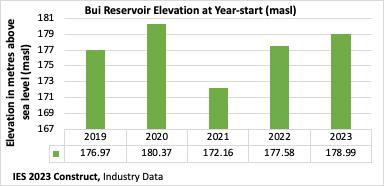
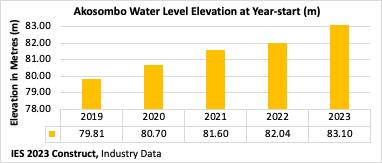
The con dence level for IES estimations remain high since there is presently no indication that 2023 seasonal in ows would be poor. Neither are there records
to show that some of the hydropower facilities may be out for service, for an extended period of time.
The IES urges the PURC and the Energy Commission to take seriously the demand-consumption assumptions and the e ects of out-turn of the projections on cost and planning, since too many a times the deviations are found to be wide.
For instance, the total energy generated from the plant in 2019 was 1,044 GWh compared to the projected of 645 GWh. Also in 2021, the total hydro generated from the Bui GS was 991 GWh as against the projected of 501 GWh. The huge deviations from projected generation and actuals is becoming a cause for concerns as it feeds into wrong assumptions, which tend to be costly.
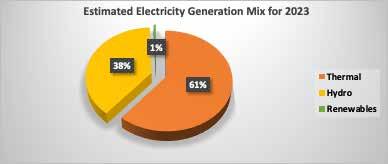
Agencies play in boosting intra-African trade.
There will be further discussions on the emerging opportunities the AfCFTA continues to present and how various development actors can leverage them to facilitate trade on the continent and boost socio-economic development.
Key speakers at this year’s summit are CEO of the GIPC & Sub Sahara’s Director on the steering Committee of the World Association of Investment Promotion Agencies, Yo Grant, and Ismail Ersahin, Executive Director for World Association of Investment Promotion Agencies (WAIPA).
table and discuss where we are and where we want to go.”
“This is why we are convening the rst of many Annual Assembly of African Investment Promotion Agencies. Through this, we hope to deepen and continue engagement for the formation on an Association of African Investment Promotion Agencies,” he added.
He further noted that the annual summit will set the tone for collective engagements on how development actors can target, channel and leverage foreign investment for mutually bene cial outcomes. He called for cooperation on increasing intra-African investment in Africa which is relatively low compared to other regions of the world.
The Ghana Investment Promotion Centre (GIPC) is set to host the First Annual Assembly of African Investment Promotion Agencies on 25th January 2023 at the Kempinski Hotel Gold Coast City in Accra.

The maiden summit will focus on “The Role of IPAs in Facilitating
Intra African Trade”. Together, the heads and representatives of the invited African Investment Promotion Agencies along with colleagues from the World Association of Investment Promotion Agencies (WAIPA), economic and political leaders will explore the critical role investment Promotion
Speaking on the importance of the summit, Yo Grant said, “By 2050, Africa will be a quarter of the global population. What if by 2050, Africa was also the recipient of a quarter of global FDI ows? As we look inward on how we can promote intra-African trade through the AfCFTA, Africa needs to rede ne how we look outward towards our investor partners. This rede nition is best created when we sit around the
There are currently about 48 African Investment Promotion Agencies (IPAs), and the Annual Assembly of Investment Promotion Agencies will serve as the o cial gathering for African IPAs to engage in discussions, exchanges, and knowledge sharing on policies, interventions, current trends in FDI, best practices on investment promotion, the AfCFTA, among other topics.
the charge in rede ning the modern workplace and how to access nancial products and services. The recent pandemic has also contributed to a transformation of the banking model and how service is rendered. Customers are asking for new things such as a shift to branchless banking and virtual transactions.
Banks, therefore, have a lot on their hands in order to harness the requisite skills necessary to keep their customers satis ed.
A recently published KPMG Banking Industry Customer Experience Survey 2022 ranked Absa Bank amongst the top 3 in customer service in Ghana. Absa has consistently moved up in the KPMG rankings, starting in 10th position in the rst roll out of the survey in 2016 and maintaining a top 3 position since 2020.
"We are thrilled to see that our e orts to become the most customer-obsessed bank in Ghana are paying o ," said Evelyn Acquah, Chief Customer O cer at the bank. "Our colleagues have worked hard to provide excellent customer service and we are proud to see that re ected in this survey. Our target is to be a consistent number one in the industry."
Absa plans to roll out new and innovative ways to take its customer commitment to the next level this year.
“We are constantly asking the most critical questions about our operating model and how we can increasingly stand beside our customers and o er them ease and convenience. It is an ethos and approach to work that de ne the Absa way of doing things, Evelyn said.
ness is to create and keep the customer. No matter what the
dictating the way banks must relate with them. They are leading
The survey highlighted several key areas of strength for Absa, including empathy, personalization, time and e ort, exceeding expectations, integrity, and resolution. The bank was also highly rated for the ease of transferring money between accounts and mobile wallets, with special mention given to its ATM QR code functionality for withdrawing money.
The bank has been an ever-present nancial institution in Ghana’s banking industry over the last century, playing a crucial role in the country’s socio-economic growth and transformation. The bank aims to continue improving the experience of its customers through the provision of innovative products, digital channels and excellent service delivery.
A release issued by the Ghana Stock Exchange (GSE) and copied GraphicOnline said; “Eno Ofori-Atta is an accomplished professional with over 15 years of experience in banking and nancial services, providing strategic leadership, creating high performance teams across business units and functions at various
She has vast experience in driving business growth, credit administration, risk management, human capital management, the development of business systems, strategic planning and strengthening of internal control systems and
improvements.
She is a former Chief Executive O cer of Pay ex Micro nance Company and former Chief Risk O cer of Women’s World Banking Ghana. The release said her diverse experience has seen her serve in various leadership roles including Branch Operations Manager, Head of Administration and Human Resources, Head of Risk and Head of Credit Operations.
Mrs Ofori-Atta is a product of Kwame Nkrumah University of Science and Technology where she obtained both a Master in Business Administration and Bachelor of Arts degree in Social Sciences (Law & Sociology).
ta, as its new Deputy Managing Director.
Her appointment takes e ect from December 1, 2022.
leadership and direction for the bank to be amongst the top-tier banks in the country while continuing its core focus of
Prior to her appointment, Mrs Ofori-Attah was the Group Managing Director of SIC-Financial Services for ve years where she led the re-de nition of the business strategy, transformational programmes and operational

The ADB Managing Director, Mr Alhassan Yakubu-Tali, congratulated Mrs Ofori-Atta on the appointment and said “Eno brings to the fore a very rich banking experience which will immensely bene t the growth of the Bank.”

Authority (SIGA) is awaiting approval from Cabinet on the listing of selected state-owned enterprises (SOEs) that have the potential of making pro t on the Ghana Stock Exchange.
Amb. Edward Boateng, the Director-General of SIGA, announced this at an Editors’ Forum last Thursday at the authority’s o ce in Accra.
tion to cabinet, so we waiting for the decision of cabinet, I think once they come up with the approval, we can make that public, we are working very closely with the Ghana Stock Exchange.
It is important to all of us that we use that cheaper source of funding to push some of these entities forward.”
The Authority, he said, would also facilitate e orts for the SOEs to secure local and international partnerships with prospective investors towards making them nancially viable, pro table and enable them pay dividends to government.
Mr. Boateng said SIGA, although created about three years ago, was working to secure its mandate and also position it as e cient and excellent entity, and demands same from entities under its watch.
Further, he indicated that the e ciency with which some SOEs are working will translate in this year’s Attorney-General’s report with fewer infractions being recorded ; “ I have every conviction that this year, 2023 Auditor-General’s report may be one of the best in the country because the infractions are going to reduce and nobody wants to come and sit in front of SIGA for the tough questions.”
The maiden SIGA Editors’ Forum was themed “Understanding the Role of SIGA”, the forum is an initiative of SIGA is intended to strengthen the existing relationship between the Authority and
the media and provide the public with accurate information by way of data, facts, statistics and new developments.

Mr. Boateng lauded the role of the media in nation-building and stressed their importance as key stakeholders in disseminating information and educating the public on activities of Speci ed Entities.
He said SIGA was established to oversee government interests in the Speci ed Entities to ensure they operate pro tably and e ciently.
“We are therefore poised to make a change to support His Excellency the President Nana Addo Dankwa Akufo-Addo’s vision for Speci ed entities to contribute 30% to Ghana’s GDP. In light of this, our stakeholders and Ghanaians must be informed of the numerous programmes and initiatives that our Speci ed Entities are implementing to help the country's socioeconomic development. As a result, we will need your understanding and support to communicate our progress, challenges, and success stories to the public,"
The Ghana Stock Exchange (GSE) has approved a request by the Ghana Association of Banks (GAB) on behalf of the listed banks for the ling of 2022 audited Financial Statements to be extended to April 30, 2023.
This will enable the banks to work e ectively with their external auditors to achieve the audit
In a press release issued by GSE in Accra today, it said the Association indicated that their ongoing discussions on the Government of Ghana Debt Exchange programme has a ected the nalisation of nancial statements for the year ended December 31,


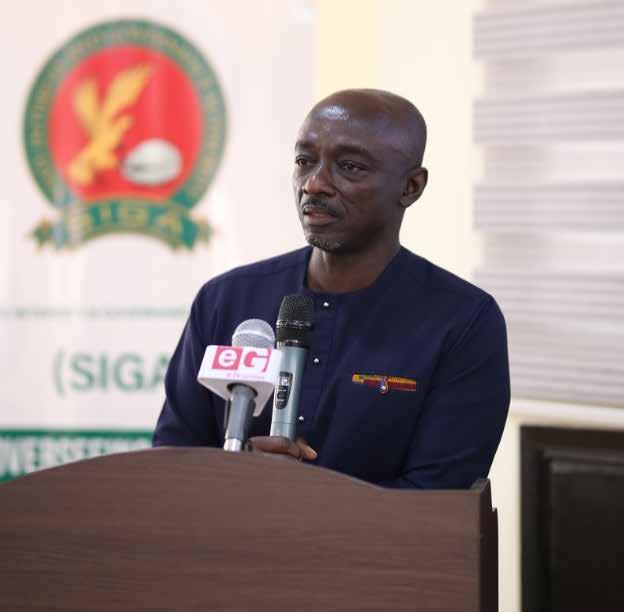
2022, by external auditors of the banks.
“In particular, the deliberations have implications for the assessment of Expected Credit Losses and its impact on 2022 nancial statements.
“It is against this background that the date for ling of 2022 audited nancial statements is extended by one month to April 30, 2023,” it said.
It added that the banks that can conclude their audit on time, after the ongoing discussions were encouraged to publish their audited nancial statements within the existing statutory timeline.
reveals that Its successful implementation will positively impact Africa’s GDP, trade and welfare.
eco-friendly, and 50 times cheaper compared to the conventional concrete house. Now is the time for us as Ghanaians and Africans at large to embrace these innovations reinvented by 66 Engineering to build that enviable motherland of African states for ourselves and posterity.
The implementation of the African Continental Free Trade Area (AfCFTA) should be expedited as the free trade zone will boost intra-African trade and accelerate industrialization, the Economic Commission for Africa (ECA) Acting Executive Secretary, Mr. Antonio Pedro, has urged.
With the AfCFTA Agreement in place, intra-African trade could be 34% higher in 2045 than without the AfCFTA in the same year. Hence the e ective implementation of the AfCFTA Agreement will help Africa industrialize and diversify away from energy and mining, said Mr. Pedro.
to mitigate the potential negative impacts of future external shocks.

Speaking at the opening of the regional consultation on LDC5 for LDCs, World Trade Organisation (WTO) Under Secretary, Rabab Fatima, urged the global community to speedily help LDCs better access international trade and global value chains.
ever materialized in Ghana where several attempts to build citizens of the state failed for decades? The evidence is so glaring as we keep recording huge housing population census conducted since independence. The Ghana Population and Housing Census of about 1.8million. The ripple dramatic increase in slum communities, unapproved settlements, and substandard residential structures across major cities in Ghana particularly Accra. The state tried to change the trajectory, so did the private sector but all to no avail.
At 66 Engineering, we provide our clients with several alternatives and opportunities of building standard yet building cheaper residential homes that every of one’s income level or class of society.
“While the AfCFTA’s promise is high, that promise can be realized only if the Agreement is implemented e ciently,” Mr. Pedro said, admitting that implementing the AfCFTA Agreement and supporting African economies, particularly Least Developed Countries (LDCs), was no small task.
The regional consultation on LDC5 for LDCs is taking stock of trade elements of the Doha Programme of Action for the Least Developed Countries for the Decade 2022-2031 (DPOA). The regional consultation is organized by the World Trade Organisation and United Nations O ce of the High Representative for LDCs (UN OHRLLS), in cooperation with the Enhanced Integrated Framework (EIF).
requirements of a concrete block. The structure does not require plastering after building, no painting, (you can only polish it if onlyent color designs). Color of the house can be kept consciously by a selective choice of the clay or laterite or a mixture of the two, the building maintains an environmentally friendly temperature that there will be no need to spend a dime on air conditioner installation and the electricity to power them. Alternatively, one can garnish this structure with natural stone décor marbles to give it that luxurious taste.
In remarks at the opening of the Regional consultation on LDC5 for LDCs in Africa and Haiti, Mr. Pedro said the Doha Programme of Action for Least Developed Countries was timely for Africa whose economies have been impacted by the Covid pandemic and the
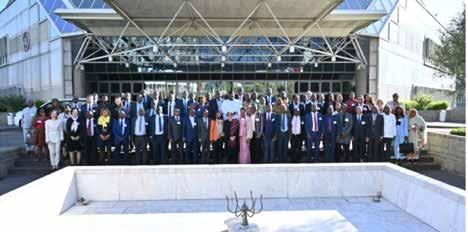
The good news however bad the situation may be today is that, 66 Engineering Ltd has reinvented the science, art and engineering of building standard residential houses that cost less than Ghs 60,000 in the capital city Accra, and even much more less in the other regions across the country.
The project in picture in this publication is one of our projects in Accra that has become the cynosure of all eyes for the past few weeks we erected this structure. This is one of our interlocking brick’s cheaper building solutions. The bricks by designed have two (2) round holes and a small rectangular perforation in the middle. These holes are purposely for mortar joints and in some cases serves as conduits for plumbing pipes, electrical cable pipes, bamboo or iron reinforcement. Remember the technology is not bricks that have been in the system that we all know. This technology is in the family of the stabilized compressed earth. It is a ratio of cement, clay or laterite, in some cases giving us a brick with average compressive strength of 8Mpa far higher than the average industry compressive strength
Welcoming the Doha Programme of Action for focusing on increasing LDCs exports and accelerating digital transformation & building institutional capacities, which were critical to Africa which has 33 of the world’s 46 LDCs.
The interior can be plastered depending on the taste and preference of the individual, or better still be sealed and polished with a special varnish cheaper than plastering and painting. Ceiling and lamp holders can be processed bamboo which is a local content input and environmentally friendly
The AfCFTA holds great promise to help LDCs recover and accelerate growth. ECA’s latest empirical assessment of the AfCFTA reform
bamboo tiles et cetera ect cetera. The reality is that, you end up having a complete house with sound and superiorstructural integrity,
By this publication, we are therefore calling on all stakeholders in the building, construction and real estate industry, all governments in the African continent, regulatory bodies, civil society 3 | P a g e organizations, international and regional associations, non-govern mental organizations et cetera to rally behind this clarion call by patronizing these innovations reinvented by this young company (66 Engineering Ltd), and also spreading the good news across the length and breadth of Africa. We are also appealing to all interna tional bodies such as the World Bank, International Finance Corporation (IFC) through the EDGE initiative, the ECOWAS community, African Union, the African Continental Free Trade Area Secretariate for partnerships, inves that 66 Engineering can do mass production of these GREEN BUILD ING TECHNOLOGY housing in gated estate communities to put shelter over the heads of the homeless majority of African people in our homeland Africa. You can reach us on: www.66engineering.com or send us a mail via 66engineeringgh@g mail.com for further information. Remember that the future is always built today and not tomor row. Imagination is our hallmark at 66 Engineering. Do not sit on the fence, join the revolution now!. 66 Engineering: Bringing Imag ination to Reality!
The ECA has facilitated deepening Africa’s participation in the battery and electric vehicle value chains through current investment projects in the Democratic Republic of Congo and Zambia.
In addition, the ECA’s work on the transboundary agro-industry park and special economic zone involving Zimbabwe and Zambia was promising and it would equip the two land-locked and least developed countries to become bread baskets for Southern Africa and possibly Africa. Mr. Pedro said the successful implementation of the AfCFTA Agreement would help build Africa’s resilience and potentially reduce its current trade dependence on external partners.
Writer: DANIEL KONTIE Position: Managing Director (66 Engineering Ltd) Contact: +233209032280
This was critical in light of the vulnerabilities exposed by the COVID-19 pandemic and the con ict in Ukraine. Africa needs
“Trade is a sine-qua-non for ensuring sustained growth and achieving the SDGs,” she said, adding, “The Doha Programme of Action for LDCs for the decade 2022-31 sets an ambitious agenda that can serve as an accelerator to promote LDCs' trade.”
While international trade has faced severe interruptions ranging from sanctions, export restrictions, energy costs, volatility in nancial markets, and disruptions in value chains, the export of goods from LDCs in 2021 amounted to US$229 billion, representing a 27 per cent increase from 2020. African LDCs recorded a 35 per cent increase in exports during the same period.
“The establishment of the Africa Continental Free Trade Agreement (AfCFTA) will further complement these e orts to boost intra-African trade; and to strengthen production and exports, create employment, and limit the impact of commodity price volatility,” Ms. Fatima said.
WTO Deputy Director-General, Mr. DOG Xiangchen Zhang, said 2023 is an important year during which the international community will be marking an important milestone in helping LDCs realize their full potential at the Fifth UN Conference for LDCs in Doha.
“Trade has been one of the forces for achieving the ambitions set out in the Doha Programme of Action for LDCs for the next decade,” Mr. Zhang noted.
The event brings together high-level government o cials from more than 30 LDCs, trade experts and academia. The outcomes of this consultation will be presented at the second part of the Fifth UN Conference for LDCs in Doha, Qatar, to be held in early March 2023.
The Ninth Session of the Africa Regional Forum on Sustainable Development (ARFSD-9) will be convened in Niamey, Niger, from 28 February to 2 March 2023.
The Forum is organized jointly by the Economic Commission for Africa (ECA) and the Government of Niger, in collaboration with the African Union Commission, the African Development Bank and other entities in the United Nations system.
The theme of the ninth session of the Regional Forum is “Accelerating the inclusive and green recovery from multiple crises and the integrated and full implementation of the 2030 Agenda for Sustainable
Development and Agenda 2063.”
The Forum will review progress made in the implementation of ve selected Sustainable Development Goals on clean water and sanitation; a ordable and clean energy; industry, innovation, and infrastructure; sustainable cities and communities; and partnerships for the Goals. This review is also situated within e orts to deliver climate action, and build resilience in a challenging era of ‘polycrises’
To be held in hybrid format, allowing for in-person and online, the Regional Forum will bring together ministers and
other high-level policymakers and experts from Governments and intergovernmental organizations. It will also attract private sector representatives, civil society organizations and other major groups, and international development partners.
Furthermore, the Forum will be a platform for the sharing of experiences, good practices and lessons learned in e orts to implement the 2030 Agenda and the Agenda 2063. Participants will identify and build a consensus on policy options and actions, to be adopted in key messages and in the Niamey Declaration.
The key messages and the declara-
tion will also serve as the collective African input to the 2023 high-level political forum on sustainable development, to be held in New York from 10 to 20 July 2023; and Sustainable Developments Goals Summit at Heads of State and Government high level week in September 2023.
The Forum will feature High level panel discussions on the implementation of the SDGs and on nancing inclusive recovery and just transitions and to accelerate implementation of the 2030 Agenda for Sustainable Development and Agenda 2063 in the context of the Parties to the United Nations Framework Convention on Climate Change (UNFCCC).
Asante Gold Corporation is on course to meet its 400,000 ounces’ gold production target after recording a 20.7 per cent increase in average monthly gold production for November and December 2022, as compared with the prior two months.
The increases were recorded from its Bibiani and Chirano Gold Mines, all located in Ghana.
In November and December, gold production on a combined basis for Bibiani and Chirano totaled 47,954 ounces for a monthly average of 23,977 ounces, up 20.7 per cent from previous 39,731 ounces or a monthly average of 19,866 ounces for September and October.
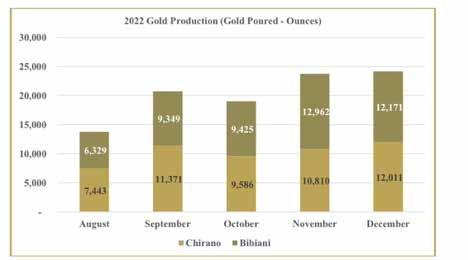
The November and December gold production monthly average was up 34.4 per cent from the monthly average of 17,834 ounces’ gold from August to October, 2022, Asante’s third scal quarter.
In a release, the company said it
also continued its record of no lost time from injuries, consolidated preliminary gold production of 23,760 and 24,180 ounces respectively for November and December; and completed nal US$30 million deferred payment, completing the Bibiani acquisition.
The company also completed US$54 million in rst and second tranche payments on the Company’s gold forward sale agreement in October 2022 and January 2023 through the delivery of 16,249.60 and 14,113.51 ounces of gold, respectively.
The CEO of Asante Gold Corporation, Dave Anthony, in the release stated that “over the past 12 months Asante has been transformed from an early-stage exploration company to a mid-tier gold producer.
“The signi cant production gains in November and Decem-

ber bode well for the achievement of our 400,000-ounce target from Bibiani and Chirano for the scal year ending January 31, 2024. Over the past ve months we have made payments totaling US$83.6 million towards closing our Bibiani acquisition and repaying our gold forward sale agreement.”
Looking forward, he said the company would continue to capture
the bene ts of owning these two nearby operating mines, which incorporate a district scale land package with signi cant exploration potential.
He said value creation initiatives were proceeding across its business as it looks to make Asante one of the top mining companies in Africa.
Farming is one of the world’s oldest and most far-reaching endeavors. Meeting the growing food demands of the global population – projected to reach ten billion by 2050 – amid accelerating climate change presents an unprecedented high-wire act that requires human ingenuity, good governance, and technology. The last time the agriculture sector went through a seismic shift like this was when new technologies, such as high-yielding wheat and rice seeds, chemical fertilizers, and irrigation technologies, kicked o the Green Revolution in the 1960s. In the following three decades, cereal production in famine-prone Asia doubled, and wheat and rice became cheaper, even though the population increased by 60% during this period.
Unfortunately, the Green Revolution brought with it a host of environmental costs. Lax regulations and generous subsidies made fertilizers and pesticides cheap, and farmers, with no training, used them excessively, leaving soil damaged and waterways polluted. As new crops took over, traditional plant varieties were lost, contributing to biodiversity loss.
The rise of robotics and arti cial intelligence might help usher in a second, even greener Green Revolution. Robots are already harvesting crops, weeding, and collecting data to improve soil management. Soon, they will be as common in farm pastures and greenhouses as they are in medical labs or Amazon warehouses. The hope is that AI can help
By Maximo Toreromeet food and climate goals by adding more precision to agriculture, thus allowing farmers to grow more and waste less.
AI-powered programs, like IBM’s Watson, combine data on weather patterns, crop yields, and market prices to advise farmers regarding the best time to plant, the precise amount of fertilizers to use, and when to harvest for peak ripeness. Researchers at Microsoft and Wageningen University in the Netherlands are growing cucumbers with the help of algorithms, combining the e orts of humans and AI to boost yields while using fewer natural resources.
In California, a state that grows irrigated fruits and vegetables at a large scale, such technologies mean real savings in seasonal labor requirements. For example, a $150,000 “grape-gobbling robot” can sort two tons of grapes in 12 minutes, replacing 15 human workers – as well as reducing the use of fertilizers, pesticides, and water, while producing higher yields.
In the past, agricultural automation was characterized by large industrial farms using heavy machinery to boost yields. Mechanization on this scale increased producers’ dependence on fossil fuels and the unbridled use of chemicals. The steep cost also meant that small farmers, especially in poorer countries, lacked access, creating an uneven playing eld.
Digital technologies are changing this to bene t both large-scale and small-scale farms. Farmers have taken a page from ride-sharing apps like Uber, using GPS tracking devices and eet-management software that allows small producers to share assets required for agricultural mechanization. Some companies, like TROTRO Tractor in Ghana and Tun Yat in Myanmar, allow small farmers to share the cost of renting a tractor they could not a ord alone.
Digital support can also upgrade traditional mechanization, even if it is not advanced technology. For example, GPS devices that track cattle (“smart collars”) and transmit data about animals’ health and movements can determine the amount of feed to dispense and automate the feeding process, improving productivity.
The great advantage of robotics is its potential for cost-e ectiveness, allowing small farmers to compete with their larger counterparts. Like computers and smartphones, these machines, once manufactured in large volumes, should become much less expensive, thus paving the way for wider use.
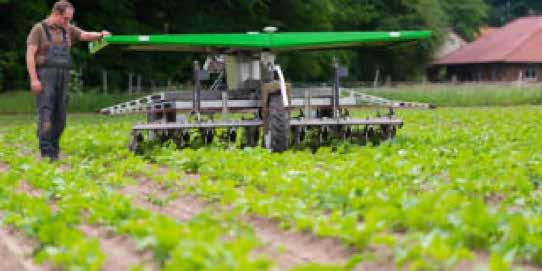
But robotics and AI-based tools, which favor highly skilled farmers over low-skilled ones, have the potential to deepen existing inequality. They could further alienate the world’s poorest people, especially those who live in rural areas and eke out a living on a small plot of land without access to markets or nancial services.
To ensure that agricultural automation, from tractors to drones, is inclusive, governments should invest in essential infrastructure, including electricity and broadband connectivity in rural areas. They should also provide training on these digital tools to create a new class of skilled farmers who can operate more advanced technologies – and can create new, high-skill opportunities for rural youth.
To be sure, technology alone will not right the world’s wrongs when it comes to delivering food more sustainably or making farming more e cient and equitable. Nor can it transform agriculture overnight. From California to Kenya, robotics and AI are still expensive and tend to favor larger farms over smaller ones. Moreover, greater use of robotics could encourage the expansion of monoculture farming systems, as robotic machines require uniformity to function e ciently. That would lead to a loss of genetic diversity. Robotics and AI in agriculture are still at an early stage of development. Thoughtful policy and rigorous impact assessments of its adoption are required to realize the Second Green Revolution’s full potential.
Robots are not substitutes for human farmers. But in a future with billions of extra mouths to feed, they can make food more sustainable, available, and cheaper to produce. It’s high time to give machines a chance.

The new President of the Chartered Insurance Institute of Ghana (CIIG), Solomon Lartey has urged all players in the nancial industry to unite in their ght against the Domestic Debt Exchange Programme.
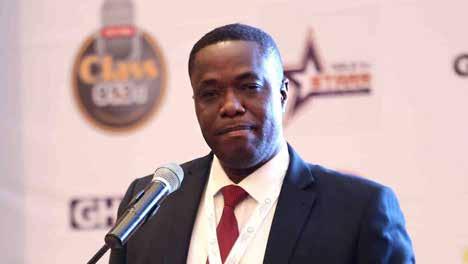
Speaking at his investiture as the new president of the Institute of Ghana, Mr Lartey, who is the CEO of the Africa Sureties and Insurance Advisory Company) said the nancial services industry including insurance, banks, securities and pensions companies must come together and speak with one voice to arrive at a suitable solution for the domestic debt exchange program (DDEP), adding that the nancial services industry is one and extremely intertwined. ‘In fact, we are di erent sides of the same coin. Whatever a ects one side, a ects the other as well,” he stated.
He said insurance companies would not be able to meet obligations with total liabilities of over GH¢5.96 billion and more than 7.5million insurance policies would be a ected if they are not exempt from the exchange, adding that thousands of people could also lose their livelihoods.
“Insurance companies (life and non-life) pay over GH¢4.3million worth of claims to companies and individuals on daily basis. This also would be lost. Note that these gures do not include pensions, health and securities, the picture is much worse than it seems,” he pointed out.
The CIIG president said it would be sad to see all the gains made to increase insurance coverage to more than 40 per cent destroyed due to this debt exchange programme.
Turning his attention to the banking sector Mr Lartey said 17 of the country’s 23 commercial banks would have their capital adequacy ratios fall below 10 per cent and require new capital injection of more than GH¢16 billion to be able to stay in business.
He said Banks losses could be as high as GH¢14.5billion and most of them would have to downsize to keep some portfolios a oat.
“This will lead to a credit squeeze and high cost of credit. The trickle-down e ect on industry and commercial activities in Ghana would be dire,” he stated.
According to the 2023 Global Risk Report by the World Economic Forum Energy supply crisis; Cost-of-living crisis; Rising in ation; Food supply crisis and cyberattacks on critical infrastructure are among the top risks for 2023 with the greatest potential impact on a global scale.
This he said was evidenced in the current economic crisis faced by Ghana namely: high in ation, depreciation of the cedi; high fuel prices; and a high national debt necessitating another visit to the IMF and the current Debt Exchange Programs.
The Chartered Insurance Institute of Ghana is the mother body of all insurance professionals in the country bringing together practitioners from life and general insurance and reinsurance, health insurance companies, broking rms, pensions, securities and trustee rms.
Mr Lartey is the 9th president of the CIIG. He took over from Mr. Tawiah Ben-Ahmed, CEO of Sanlam Life Ghana.
modern technologies, funding, electricity and broadband internet keep the youth on the sidelines of the free trade area.
At an online presentation meeting organized by the Regional Integration and Trade Division (RITD) of the Economic Commission for Africa (ECA), nine young mentees who have completed RITD’s “Youth for AfCFTA Mentorship Programme”, presented their nal assignment to senior sta in ECA.
The youth participants highlighted that the AfCFTA presented huge entrepreneurship opportunities for them but that governments need to implement supportive policies and investment to ensure their participation.
The African Continental Free Trade Area (AfCFTA) is an opportunity for young people to accelerate Africa’s industrialization and economic transformation through entrepreneurship, youths say, calling for an enabling policy framework.
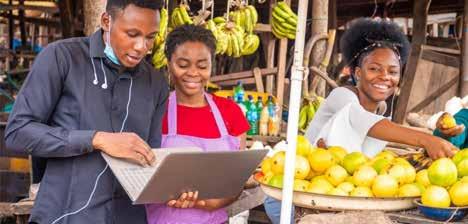
Through its Youth Protocol, the AfCFTA recognises that young people can play a critical role in the achievement of the free trade zone by initiating youth-led initiatives in agriculture, nan-
cial technology, IT and in the creative industry.
However, they note that across the youth-dominant trade areas critical to the AfCFTA, the challenges of infrastructure gap, lack of access to
Ms. Mie Vedel-Joergensen, Associate Expert in Economic A airs, Market Institutions Section of the Regional Integration and Trade Division (RITD) at the ECA said
mentees of the “Youth for AfCFTA Mentorship Programme” are winners of a competition launched in March 2022 which led to the mentorship programme in ECA.
The competition with the topic; “The African Continental Free Trade Area (AfCFTA): What is in it for young Africans?” was developed by the Youth Alliance for Leadership and Development in Africa (YALDA) in collaboration with the AfCFTA Secretariat, Afreximbank, the International Trade Centre (ITC), the UN Development Programme (UNDP) and ECA. The competition encouraged participants to develop essays, infographics or animation to communicate the potential impact of the AfCFTA on youth in Africa.
According to YALDA, the competition aimed to break information asymmetry among youth on the AfCFTA and promote a bottom-up approach to the policy formulation and implementation by harnessing innovative youth-driven solutions that will contribute to active youth engagement in the popularization of the AfCFTA.
Noting that young people can in uence policy decisions in favour of the AfCFTA in addition to providing labour, Ms. Jessica Debby Ndjadila, mentee of the Essay group, said Africa’s youth understood the technology enablers of the free trade area such as Information Technology, supply chain management, and nancial technology.
“African governments should prioritize intellectual property rights protection,” Ms. Ndjadila said, calling for scal policies to drive entrepreneurs into content distribution and the democratization of access to broadband connectivity.
Africa also needs to operationalise the Pan African Payment and Settlement System (PAPSS), a centralized payment and settlement system for intra-African trade in goods and services developed in 2022. The platform would increase the competitiveness of and investment in youth-dominated start-ups in Africa.
Another group of youth developed an infographic to highlight the
bene ts of gender inclusion in the AfCFTA. Noting that Sub Saharan Africa was losing an average of $95 billion annually as a result of gender inequality, the youth felt that investment in mobile and digital solutions can bridge the gender gap in Africa where the proportion of women using the internet was 25% lower than men.
“Implementation of the AfCFTA would increase employment opportunities and wages for unskilled workers and help close the gender wage gap,” said Mr. Richard Muraya, a youth whose group developed an infographic highlighting the opportunity cost of gender inclusion in the AfCFTA.
Mr. Stephen Karingi, Director of Regional Integration and Trade Division at ECA said young people fully understand what the AfCFTA is all about and their information products should be promoted in giving policymakers the right narrative about the free trade area. Besides, the youth have well demonstrated the potential of the AfCFTA and the issues that must be addressed by the protocols developed for the realization of the free trade area.
The African Continental Free Trade Area (AfCFTA) is an opportunity for young people to accelerate Africa’s industrialization and economic transformation through entrepreneurship, youths say, calling for an enabling policy framework.
Through its Youth Protocol, the AfCFTA recognises that young people can play a critical role in the achievement of the free trade zone by initiating youth-led initiatives in agriculture, nancial technology, IT and in the creative industry.
However, they note that across the youth-dominant trade areas critical to the AfCFTA, the challenges of infrastructure gap, lack of access to modern technologies, funding, electricity and broadband internet keep the youth on the sidelines of the free trade area.
At an online presentation meeting organized by the Regional Integration and Trade Division (RITD) of the Economic Commission for Africa (ECA), nine young mentees who have completed RITD’s “Youth for AfCFTA Mentorship Programme”, presented their nal assignment to senior sta in ECA. The youth participants highlighted that the AfCFTA presented huge entrepreneurship opportunities for them but that governments need to implement supportive policies and investment to ensure their participation.
Ms. Mie Vedel-Joergensen, Associate Expert in Economic A airs, Market Institutions Section of the Regional Integration and Trade Division (RITD) at the ECA said mentees of the “Youth for AfCFTA Mentorship Programme” are winners of a competition launched in March 2022 which led to the mentorship programme in ECA.
The competition with the topic; “The African Continental Free Trade Area (AfCFTA): What is in it for young Africans?” was developed by the Youth Alliance for Leadership and Development in Africa (YALDA) in collaboration with the AfCFTA Secretariat, Afreximbank, the International Trade Centre (ITC), the UN Development Programme (UNDP) and ECA. The competition encouraged participants to develop essays, infographics or animation to communicate the potential impact of the AfCFTA on youth in Africa.
According to YALDA, the competition aimed to break information asymmetry among youth on the AfCFTA and promote a bottom-up approach to the policy formulation and implementation by harnessing innovative youth-driven solutions that will contribute to active youth engagement in the popularization of the AfCFTA.
Noting that young people can in uence policy decisions in favour of the AfCFTA in addition to providing labour, Ms. Jessica Debby Ndjadila, mentee of the Essay group, said Africa’s youth understood the technology enablers of
the free trade area such as Information Technology, supply chain management, and nancial technology.
“African governments should prioritize intellectual property rights protection,” Ms. Ndjadila said, calling for scal policies to drive entrepreneurs into content distribution and the democratization of access to broadband connectivity.
Africa also needs to operationalise the Pan African Payment and Settlement System (PAPSS), a centralized payment and settlement system for intra-African trade in goods and services developed in 2022. The platform would increase the competitiveness of and investment in youth-dominated start-ups in Africa.
Another group of youth developed an infographic to highlight the bene ts of gender inclusion in the AfCFTA. Noting that Sub Saharan Africa was losing an average of $95 billion annually as a result of gender inequality, the youth felt that investment in mobile and digital solutions can bridge the gender gap in Africa where the proportion of women using the internet was 25% lower than men.
“Implementation of the AfCFTA would increase employment opportunities and wages for unskilled workers and help close the gender wage gap,” said Mr. Richard Muraya, a youth whose group developed an infographic highlighting the opportunity cost of gender inclusion in the AfCFTA.
Mr. Stephen Karingi, Director of Regional Integration and Trade Division at ECA said young people fully understand what the AfCFTA is all about and their information products should be promoted in giving policymakers the right narrative about the free trade area. Besides, the youth have well demonstrated the potential of the AfCFTA and the issues that must be addressed by the protocols developed for the realization of the free trade area.

The Economic Commission for Africa (ECA) is supporting regional trade integration through the African Trade Exchange Platform (ATEX), a platform enabling bulk procurement of commodities.
Speaking at a session on integrating
regional trade during the regional consultation on LDC5 for Least Developed Countries (LDCs) in Africa and Haiti, ECA Director for Regional Integration and Trade Division, Mr. Stephen Karingi, highlighted the importance of trade within the LDCs of which 33 are in Africa.
Over the past 5 years, about 80% of exports from African LDCs were destined to extra-African countries while about 79% of African LDCs imports were sourced from outside of the continent.
“Mirroring Africa more broadly, the LDC’s largely import manufactured products and export goods low along critical value chains like fuel products, ores and metals, and food items,” Mr. Karingi said, expressing concern that current trade patterns have exposed African LDCs to commodity price volatilities and global shocks.
The ECA and Afreximbank in collaboration with the African Union and the African Continental Free Trade Area (AfCFTA) Secretariat, have developed a digital B2B and B2G ATEX. The platform provides a safe and secure digital marketplace for pooling Africa’s trade demand, as well as a one point of transparent and competitive access to critical supplies.
Mr. Karingi explained that ATEX digitally enables the trade of the main agricultural commodities and
inputs imported by the continent from Russia and Ukraine. These include cereals, fertilizer and associated inputs, oils, oilseed, other products and inputs that support agricultural value chains.
The ATEX trade platform has been established on the back of the establishment of the AfCFTA, which, if fully implemented, is set to accelerate industrialization in Africa and increase the value of intra-African trade by 400 percent and the share of intra-African trade to 26 percent by 2045. This is compared to the share of intra-African trade which was at 15 percent in 2020.
“The impact of the AfCFTA on intra-African trade is likely to be much higher as the above estimates don’t consider informal cross-border trade which is prevalent in most African LDCs,” said Mr. Karingi, adding that while the AfCFTA is expected to impact countries di erently based on their existing comparative advantages, all African coun-
tries will bene t.
Trade gains are expected mostly in the industry, agrifood and services sectors. For example, Ethiopia’s intra-African agrifood sector is expected to grow by 84% and the industry sector in Benin by 63%.
The ECA is helping African countries, many of which are LDCs, in developing their national AfCFTA implementation strategies.
Furthermore, the ECA has conducted research with Organisation for Economic Co-operation and Development (OECD) and gathered data on Digital Services Trade Restrictions across African countries. Of 28 countries with data, ECA has collected data on 17 LDCs which shows di erent trade restrictions across African countries. For example, little restrictions in Gambia and high restrictions in Tanzania with infrastructure being the most common restriction found.
Despite the trade and industrialization prospects for LDCs o ered by the AfCFTA, there were many barriers to industrialization for LDCs. For instance, productive actors are
largely resource- and talent-poor Micro Small and Medium Enterprises which were disproportionately led by women and youth including those in the informal sector.

Noting that women face constraints to participation in trade, including access to assets, nance, markets, information, networks, skills, standards, tech, security at borders, Mr. Karingi said inclusive complementary policies were necessary for national and regional AfCFTA implementation. In line with this, the African Union Assembly decided to include the Protocol on Women and Youth in Trade in the scope of the AfCFTA Agreement. and ECA ensures that gender policy is mainstreamed in the national AfCFTA implementation strategies.
“African LDCs are extremely vulnerable to global shocks due to their current trading patterns and the AfCFTA will be instrumental in cushioning African LDCs from external shocks and bolstering the industrialization of these countries,” said Mr. Karingi.





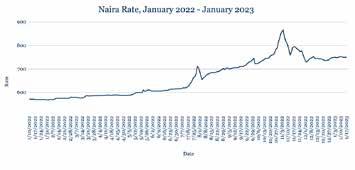
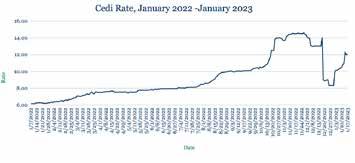




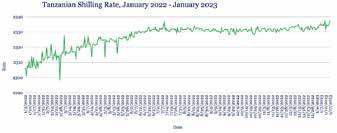
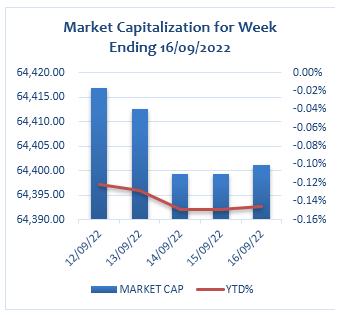

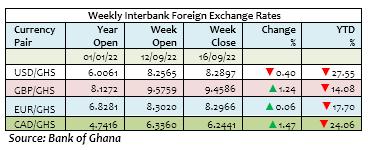






Q3, 2021 GDP Growth 3 3% Average GDP Growth for 2021 3 3% 2022 Projected GDP Growth 3 7% BoG Policy Rate 22 0% Weekly Interbank Interest Rate 22 05% 33 9% 28 5% 5 0% 6 6% 393 4% 78 3%
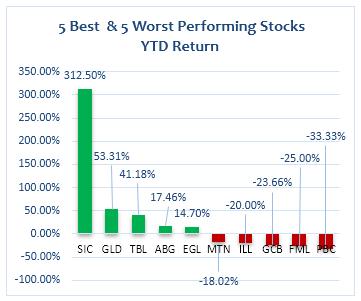
The Ghana Stock Exchange closed lower for the second consecutive week on the back of price declines by 7 counters The GSE Composite Index (GSE CI) lost 8 49 year-to-date (YTD) loss of 10 38%. The GSE Financial Stocks Index (GSE FI) also lost 5 52 points (-0 27%) to Market capitalization declined by 0 13% to close the YTD decrease of 0 15%. preceding week
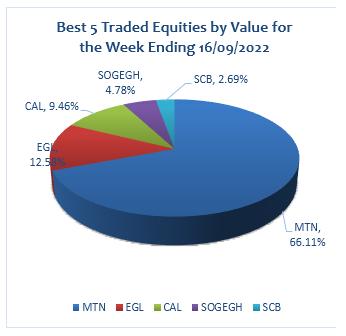
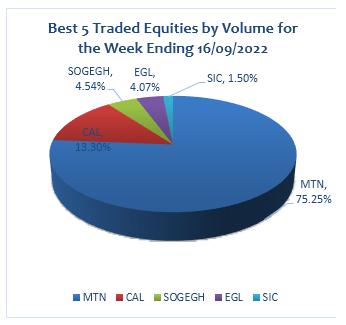


MTN dominated both volume and value of trades for traded respec tively The market ended with no advancer and decliners as indica le below
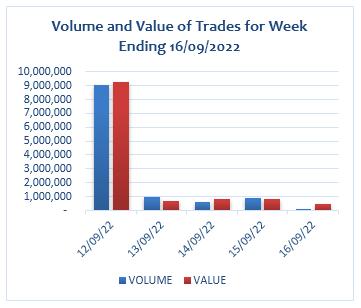
The Cedi continued its downward trend against the USD for the week It traded at GH¢8 2897/$, compared
YTD depreciations of 0 40% and 27 55% respec tively ago
The Cedi however strengthened against the GBP
YTD depreciation of 1 24% and 14 08% respec tively This

The Cedi also strengthened against the Euro for ago
The Cedi again strengthened against the Canadian


TD depreciation of 1 52% a year ago

Madam Botchwey said those high-level visits saw the signing of agreements and MOUs on Bilateral Cooperation, Avoidance of Double Taxations, and Visa Wavers for diplomatic and service passports. She lauded Dr Borg on the commissioning of Malta’s High Commission building in Accra, which solidi es Malta’s presence in Ghana and also commended him for leading 50-member business delegation to Ghana.
of the Commission for implementation.
She said Ghana was working towards opening direct air transport between Accra and Valletta, the capital of Malta, and expressed gratitude to Malta for providing scholarships to Ghanaian students and donating vaccines to Ghana.
(MoUs) on Cooperation, Sports and Youth Development, Fisheries and Education in Accra to improve Maltese assistance to these sectors and enhance their activities.
Madam Shirley Ayorkor Botchwey, Ghana’s Minister of Foreign A airs and Regional Integration, held a meeting with Dr Ian Borg, Malta’s Minister of Foreign and European A airs and Trade, after which the MoUs were signed.

Madam Botchwey and Dr Borg signed the Ghana–Malta Permanent Joint Commission for Cooperation (PJCC), while Mr Mustapha Ussif, the Minister of Youth and Sports, signed the MoU on Sports and Youth Development.
The MoU on Fisheries was signed by Mr Moses Anim, the Deputy Minister for Fisheries and Aquaculture Development, while that of Academic Cooperation between
of Malta and the Legon Centre for International A airs and Diplomacy (LECIAD), University of Ghana, was signed by Professor Emmanuel Debrah, Director, LECIAD.
Madam Botchwey noted that Ghana treasured the strong relations between the two countries, a relation that dates back to the early 1970s.
She recounted the numerous bilateral cooperations including the visit to Accra by the then Maltese President, Marie-Louise Coleiro Preca in 2017, which was reciprocated in 2019 by President Nana Addo Dankwa Akufo-Addo.
She said Otumfuo Osei Tutu II, the Asantehene, and Nana Otuo Siriboe II, the Chairman of the Council of State, were in Malta for a visit.
Linking the private sectors of the two countries was extremely important because they needed to see very tangible results of their cooperation in terms of economics and trade investment ties, to make Ghana and Maltese relations visible, Madam Botchwey said.
“We want your businesses to see Ghana not just as a market of 31 million people but a Ghana that is a steppingstone into the West African market, which is over 300 million,” she noted.
“And also, to see Ghana, even more as that stepping stone into the 1.3 billion market of the (Africa) Continental Free Trade Area (AfCFTA).”
Touching on the Permanent Joint Commission for Cooperation, Ghana’s Foreign Minister said appending their signatures meant that they were endorsing the work
Madam Botchwey congratulated Malta for being part of the United Nations Security Council (UNSC) as a non-permanent member and where members would be working together to make the world a better place.
Dr Borg, on his part, commended Ghana’s democratic credentials and for being a shining example in the Sub-region.
He said Malta opened her rst Embassy in Sub-Saharan Africa in Accra because Ghana was the most politically stable country in the region.
He noted that the high-level visits between the two countries spoke volumes, coupled with the MoUs, which indicated the wide areas of bilateral collaboration.
Mr Ussif, in an interview with the Ghana News Agency, said the MoU on Sports and Youth Development would enhance exchange programmes between the two countries.

Source: GNA
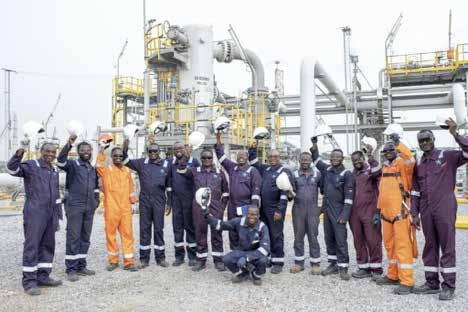
their contractors and stakeholders to ensure that the shutdown activities were safely and seamlessly executed and completed days ahead of schedule.
fully completed the valve replacement works at its Takoradi Regulating and Metering (R&M) Station. WAPCo on January 12, 2023, shut down the Takoradi facility to allow for the replacement of some critical
Manager, Corporate A airs, indicated that the replacement exercise was projected to last for 10 days.
He said the WAPCo project team worked collaboratively with
According to him, the early completion of the works was an outcome of the review and optimization of the execution strategy by WAPCo’s team and the Contractor. “WAPCo is grateful to the West African Gas Pipeline Authority (WAGPA), Ministry of Energy (MoE), the Ghana Grid Company Ltd (GRIDCo), the Volta River Authority (VRA), the Ghana National Petroleum Corporation (GNPC), the Ghana National Gas Company (GNGC), the Electricity Company of
Ghana (ECG) and other key stakeholders for their support to minimize the impact of the shutdown on communities as well as the safe and successful execution of this project.”
The West African Gas Pipeline Company Limited (WAPCo) owns and operates the West African Gas Pipeline (WAGP), a regional infrastructure linking natural gas resources to customers with a growing demand for cleaner and more e cient energy in the West Africa sub-region, especially in Ghana. The WAGP is a bi-directional pipeline system with gas supply from both east (Nigeria) and west (Ghana) of the pipeline system.